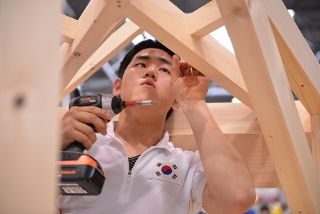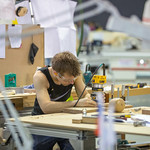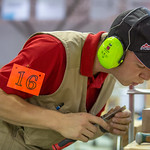Carpentry
Skill Explained
A carpenter generally works on commercial and residential projects. Carpentry is closely associated with other parts of the construction industry, and with the many products that support it, normally for commercial purposes.
The carpenter works internally and externally, including in the homes of customers and on building sites in all weather conditions. He or she will interpret drawings, set out and measure, cut, form joints, assemble, install and finish to a high standard.
The carpenter’s work includes:
• Measuring, cutting and installing components of a residence or commercial building including floor, wall and roof systems. It can also include stairs, interior and exterior finishes, roofing materials, doors, windows and other finishing components. Accurately measuring and cutting enables greater quality for items like trim and moulding which must be finished with great precision
• Constructing forms for concrete, wall and roof systems of the structures
• Installing components that are seen on the inside and outside of residential or commercial buildings such as sidings, shutters, roofing materials, as well as out-buildings such as garages, sheds, gazebos, pergolas and play houses.
Work organization and self-management, communication and interpersonal skills, problem solving, innovation and creativity, and working precisely and accurately, are the universal attributes of the outstanding carpenter. Whether the carpenter is working alone or in a team the individual takes on a high level of personal responsibility and autonomy.
Every step in the carpentry process matters; mistakes are largely irreversible and have a very high cost. This means that the carpenter must work safely and tidily, have stamina, demonstrate exceptional planning and organization skills, concentrate and pay attention to detail in order to achieve an excellent finish.
With the international mobility of people, the carpenter faces rapidly expanding opportunities and challenges. For the talented carpenter there are many commercial and international opportunities. However these also carry with them the need to understand and work with diverse cultures and trends.
A carpenter usually receives his or her training by working as an apprentice with a more experienced professional. Training normally includes using hand and power tools; doing rough and finish carpentry work; learning how more intricate jobs are completed, and the importance of accuracy.
What the Competitors do at the Competition
The Competitor is judged on:
- Their ability to read and interpreting drawings and written instructions
- Accurate planning and setting out
- Forming neat joints and preparing wood for assembly.
- Assembling and fastening all components of the structure with a high level of precision.
- Producing a neat finish that conforms with the specifications.
The Competitor has to carry out the following task:
- Draw sufficient details of the project to determine the length, shape, angles and joints for each piece of wood.
- Mark out the wood accurately.
- Prepare the materials by cutting to length, forming bevels and forming joints.
- Assemble the project using a variety of fixing devices.
Competitors
Rashed Al Mohamed
United Arab Emirates
Raphaël Baumberger
Switzerland
Seung Woo Cha
Korea
Rupert Ebner
Austria
Maxime Gauvreau
Canada
Matty Hull
New Zealand
Owain Jones
United Kingdom
Osward Kabwe
Zambia
Jasper Luft
Netherlands
Axel MELLERIN
France
David Morgan
Ireland
Antoine Pernuit
Belgium
Lev Proskura
Russia
Simon Rehm
Germany
David Rottensteiner
South Tyrol, Italy
Luiz Felipe Souza
Brazil
Daniel Stolz
Luxembourg
Thorbjørn Stryger
Denmark
Gergo Szucs
Hungary
Shin Wakabayashi
Japan
Experts

Ahmed Al Hamadi
United Arab Emirates

Roland Bernardi
Germany

Willem Beverloo
Netherlands

Siegfried Brunner
South Tyrol, Italy

Dina Chernykh
Russia

Sam Dean
New Zealand

Christian Engel
Luxembourg

Waldemar Furbringer
Brazil

Herb Grootenboer
Canada

Richard Hable
Austria

Shigeki Kataoka
Japan

Jonathan LAHAYE
France

Balazs Major
Hungary

Pat Noonan
Ireland

Alex Nygaard
Denmark

Chintu Patrick James
Zambia

Pat Phillips
United Kingdom

Byoung Jin So
Korea

Thomas Varin
Belgium

Adrian Wenger
Switzerland
Videos
A New Look at Skills
Autodesk Publisher 3D models*
Download for desktop
Download for mobile
Autodesk Inventor Data Sets**
* Open the 3D models on desktop with Autodesk Inventor Publisher. On mobile download the Autodesk Inventor Publisher Mobile Viewer app (iOS or Android).
** Students and Teachers can download Autodesk Inventor software via the Autodesk Student Community, Educational Institutions via Autodesk Academic Resource Centre (ARC).







































